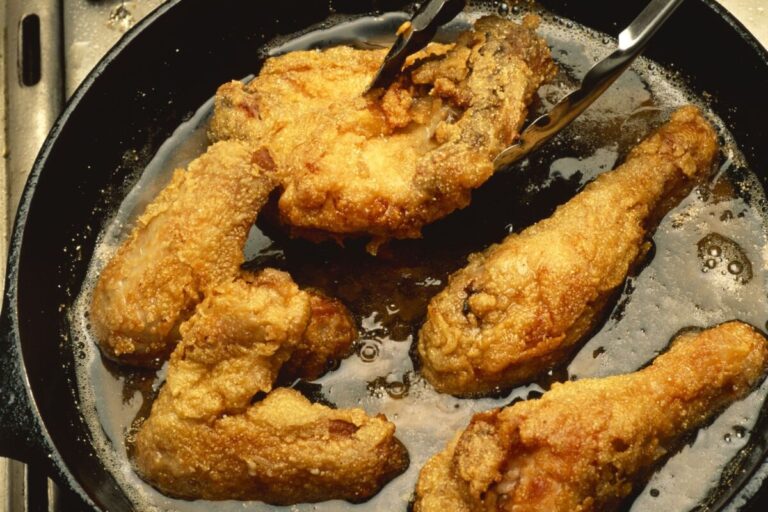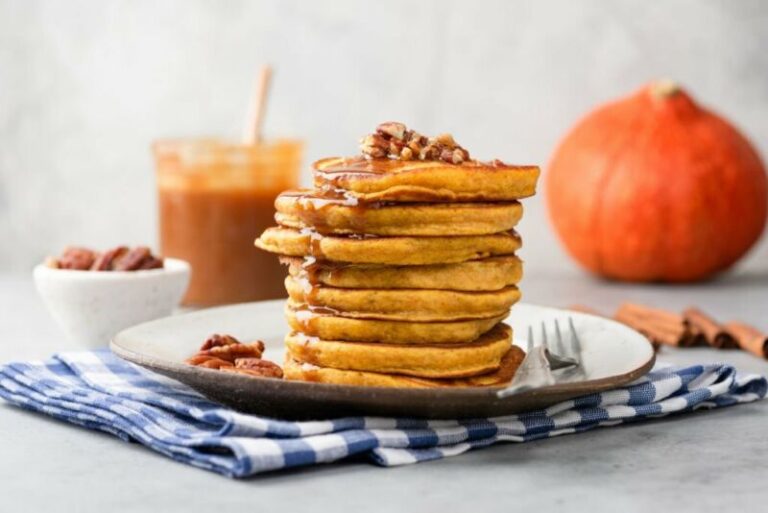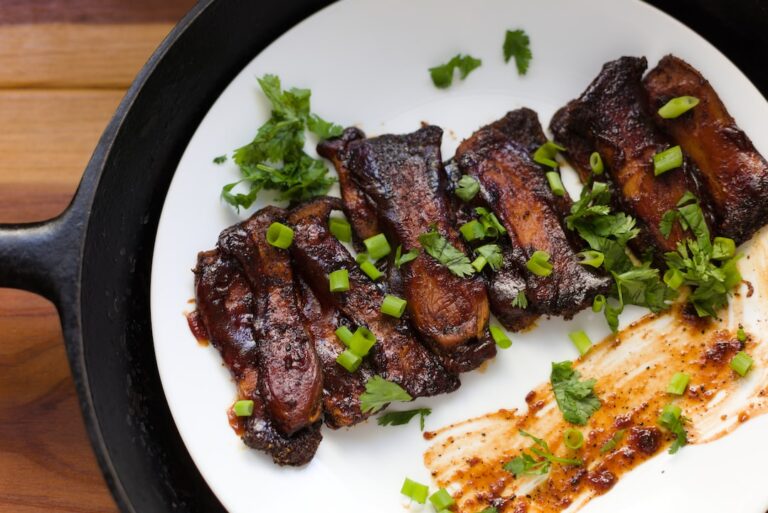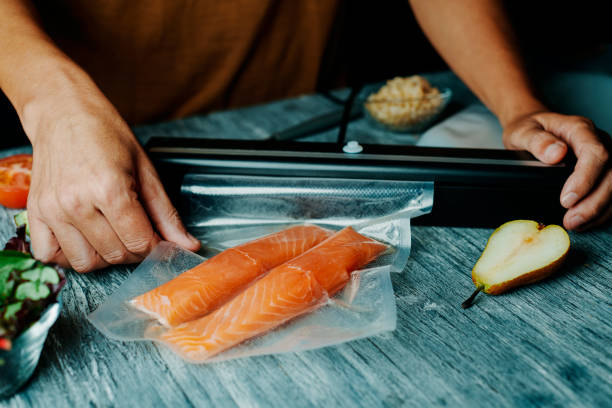How Long Does Corned Beef Take To Cook?
Corned beef, a cherished delicacy deeply ingrained in American culinary traditions, has remained a steadfast favorite among families throughout generations. Its tender and succulent texture, coupled with its distinctive flavor, has solidified its enduring appeal.
However, if you find yourself unfamiliar with the art of crafting corned beef or simply seek to refine your skills, you might ponder, “How long does corned beef take to cook?” Fear not, for this article aims to equip you with all the necessary knowledge to consistently create exceptional corned beef dishes.
We will delve into the various cooking methods available, explore the factors that influence cooking time, and uncover techniques to prevent the meat from becoming dry and lackluster.
Whether you are an experienced cook or a novice embarking on your culinary journey, this comprehensive blog post serves as an invaluable resource to master the art of preparing corned beef. So, shall we begin our culinary exploration together?
How Long To Cook Corned Beef
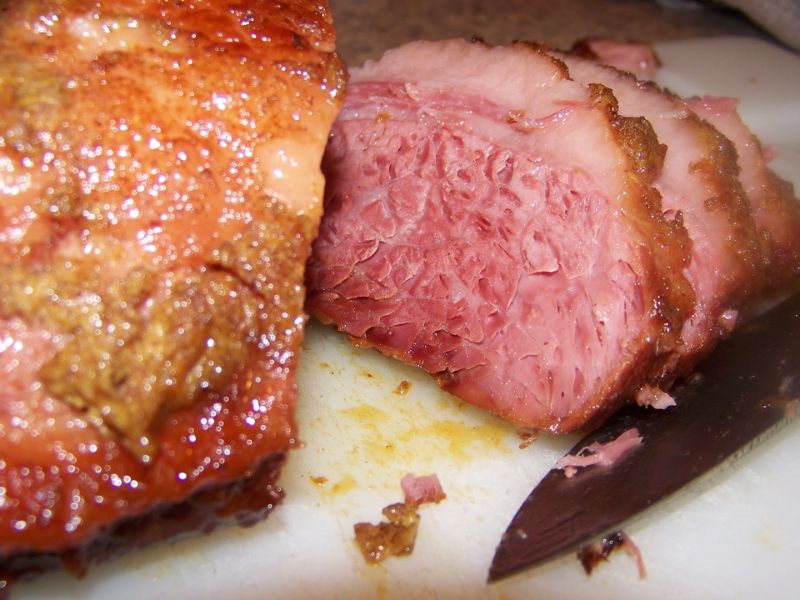
The cooking time required for corned beef varies based on the chosen cooking technique and the size of the meat. Below are some guidelines to help you achieve a perfectly cooked corned beef.
One popular method for cooking corned beef on the stovetop is simmering. For a 3 to 4-pound corned beef brisket, allow it to cook for a minimum of 3 to 4 hours. Begin by immersing the meat in water until it is fully covered, then cook it slowly over low to medium heat.
Another commonly used technique is using a slow cooker. The cooking time for corned beef in a slow cooker depends on the size of the brisket. On low heat, a corned beef brisket should cook for 8 to 10 hours, while on high heat, it can be cooked in 4 to 6 hours.
If you prefer to bake your corned beef, preheat the oven to 325 degrees Fahrenheit (163 degrees Celsius). Place the corned beef in a roasting pan and add enough water to come just below the meat. Cover the pan with foil and bake for approximately 3 to 4 hours, or until the meat is fully cooked. During the last hour of cooking, you can also add vegetables such as potatoes, carrots, and cabbage to enhance the flavors.
It is important to remember that these are general recommendations, and the actual cooking time may vary based on factors like the type of meat, desired tenderness, and personal preferences for doneness. To ensure that the corned beef is cooked thoroughly, the internal temperature should reach at least 145 degrees Fahrenheit (63 degrees Celsius), which can be checked using a meat thermometer.
How Long To Cook Corned Beef In Slow Cooker
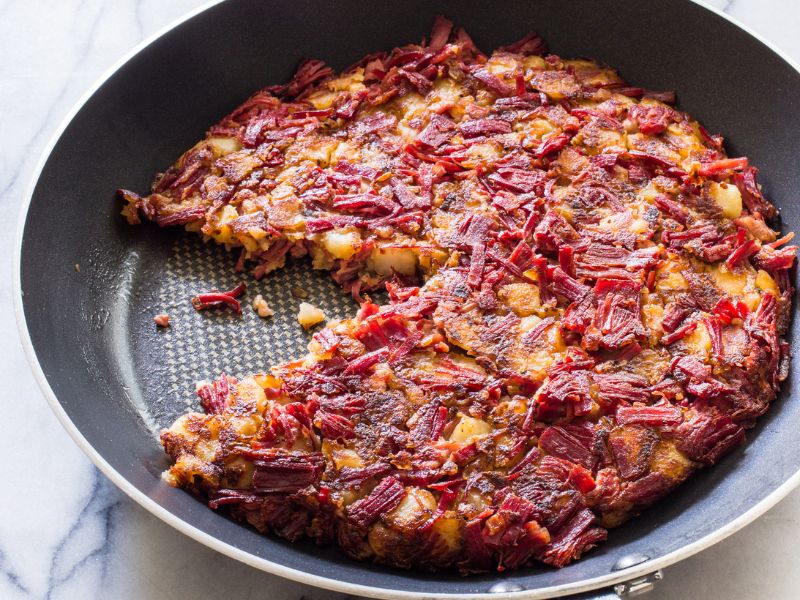
To achieve tender and flavorful corned beef, the slow cooking method in a slow cooker is highly recommended, although it does require a significant amount of time. Here’s a detailed step-by-step guide on how to successfully slow cook corned beef:
- Begin by placing the corned beef in the slow cooker with the fatty side facing upward. This allows the fat to melt and baste the meat, enhancing its juiciness and flavor.
- Add your preferred vegetables to the slow cooker, along with the seasoning package that typically comes with the corned beef. Additionally, feel free to include any other spices or herbs of your choice to personalize the flavor profile.
- Ensure that the meat and vegetables are adequately covered with water or broth within the slow cooker. This moisture is crucial for maintaining a moist environment throughout the cooking process.
- Adjust the settings on your slow cooker to low heat and set the cooking time to approximately 8-10 hours. The low and slow cooking method allows the collagen in the meat to break down gradually, resulting in a more tender corned beef. It is preferable to opt for a longer cooking duration rather than rushing the process by cooking it quickly for 4 to 6 hours.
- To check the doneness of the corned beef, carefully insert a fork into the meat. If the fork slides in and out effortlessly, it is a sign that the corned beef is likely ready. However, if there is resistance or the meat feels tough, allow it to continue cooking until it reaches the desired tenderness.
- Once the corned beef is cooked to perfection, remove it from the slow cooker and let it rest for a few minutes. This resting period allows the juices to redistribute within the meat, ensuring optimal flavor and tenderness.
- Before serving, slice the corned beef against the grain. This technique helps to break up the muscle fibers, resulting in more tender and easier-to-chew slices.
How Long To Cook Corned Beef In Oven
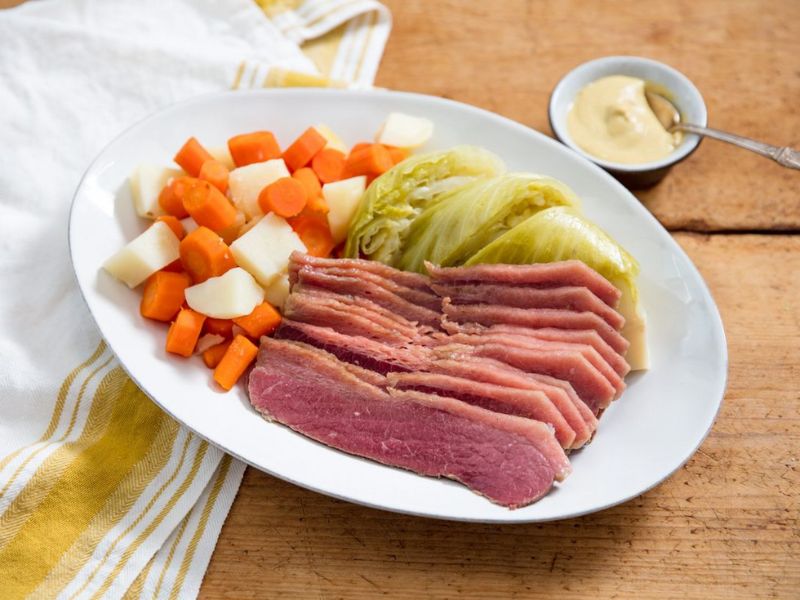
Roasting corned beef in the oven requires careful consideration of the meat’s quantity and desired tenderness, with a cooking time ranging from 3 to 4 hours. To ensure a delicious outcome, follow these step-by-step instructions:
- Begin by preheating the oven to 325 degrees Fahrenheit (163 degrees Celsius).
- Rinse the corned beef under cold water, effectively removing the brine, and then return it to its original packaging.
- Select a large, covered saucepan or roasting pan capable of withstanding oven temperatures. Place the corned beef in the chosen container. If your corned beef came with a seasoning package, this is the opportune moment to utilize it.
- Add enough cold water to the pan so that the corned beef is submerged by approximately 1 inch (2.5 cm). Feel free to enhance the flavors by incorporating onions, garlic, and spices according to your preferences.
- Cover the pot or roasting pan with its lid or securely wrap it in aluminum foil, ensuring no steam can escape during the cooking process.
- Position the saucepan or roasting pan in the preheated oven and allow it to cook for three to four hours. Remember that the cooking time may vary depending on the quantity and thickness of the corned beef. For precision, consider using a meat thermometer to determine the exact interior temperature. Corned beef is considered done when the internal temperature reaches 145 degrees Fahrenheit (63 degrees Celsius) for medium-rare or 160 degrees Fahrenheit (71 degrees Celsius) for medium.
- Once the corned beef has achieved the desired tenderness, carefully remove it from the oven. Allow it to rest for a few minutes to retain its juiciness before proceeding to slice it against the grain.
- It’s important to note that these instructions serve as general guidelines, and individual preferences may vary. To ensure the corned beef is cooked precisely to your liking, rely on a meat thermometer to monitor its doneness.
How Long To Boil Corned Beef
When it comes to boil corned beef, it is generally recommended to simmer it for approximately 2.5 to 3 hours per pound (0.45 kg) of meat. Follow the instructions below for boiling corned beef:
- Begin by selecting a large saucepan or Dutch oven to accommodate the corned beef.
- Place the corned meat in the chosen pot, ensuring it fits comfortably.
- Add enough water to fully cover the meat in the pot.
- Depending on your preference and the recipe, you can enhance the flavor by adding spices or vegetables like onions, carrots, and celery. However, this step is optional.
- Set the heat to high and bring the water to a boil.
- Once the water starts boiling, reduce the heat to low or medium to maintain a steady simmer.
- Allow the corned beef to simmer for the recommended duration based on its weight. Remember to cover the pot during this process.
- To determine if the corned beef is cooked to your desired level, use a fork to test its doneness. If the fork easily slides in and out without resistance, the corned beef is likely done.
- Once cooked, remove the corned beef from the saucepan and let it rest for a few minutes before slicing.
How Long To Bake Corned Beef At 350
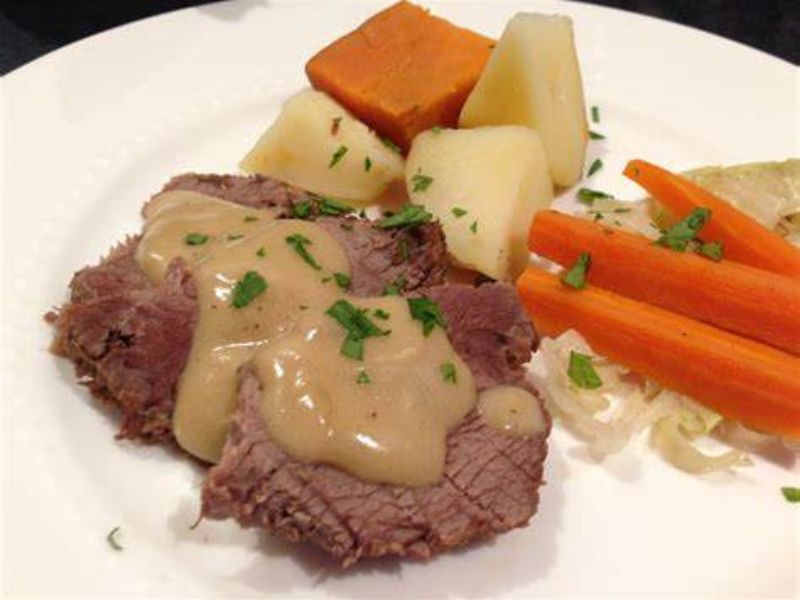
The cooking time for corned beef may vary depending on its size and shape. However, a general rule of thumb is to bake corned beef at 350 degrees Fahrenheit (175 degrees Celsius) for approximately 30 minutes per pound (454 grams).
For example, if you have a 3-pound (1.36 kg) corned beef, you would bake it for about 1 hour and 30 minutes (3 pounds * 30 minutes = 90 minutes). It’s important to remember that this is just a rough estimate, and it’s always recommended to use a meat thermometer to ensure the corned beef is cooked to the desired level of doneness.
To achieve the ideal internal temperature for cooked corned beef, aim for 145 degrees Fahrenheit (63 degrees Celsius) for medium-rare or 160 degrees Fahrenheit (71 degrees Celsius) for medium. Since corned beef is typically a tougher cut of meat, you might find that it requires a longer cooking time or alternative cooking methods like braising or slow cooking to achieve a more tender texture.
Best Way To Cook Corned Beef
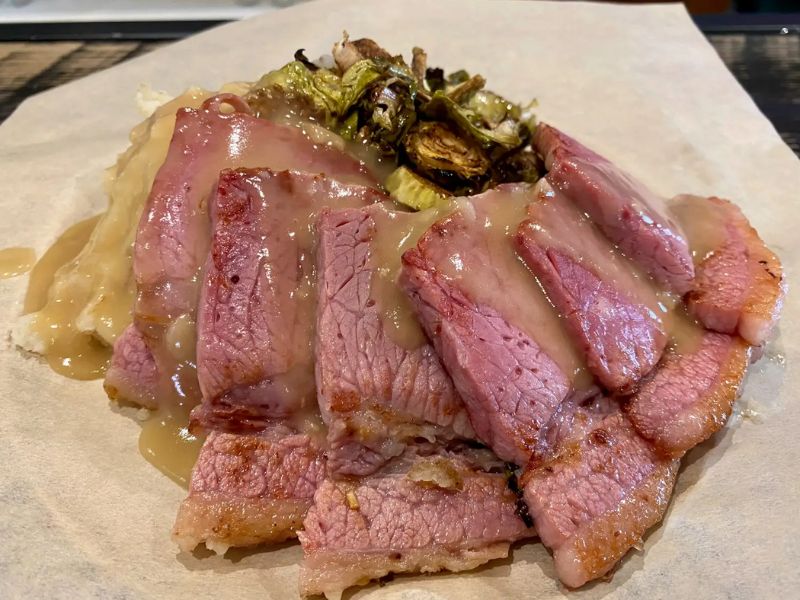
How to Cook Corned Beef on the Stovetop
One popular and traditional way to cook corned beef is by using a pot on the stove, and the best part is that you don’t need any specialized equipment to do it. Here’s how you can effectively prepare it using this method:
Start by placing a corned beef brisket, along with some carrots, celery, and a quartered onion, into a generously sized saucepan or Dutch oven with a tight-fitting lid. As the corned beef simmers, these vegetables will release their delicious flavors into the cooking liquid, enhancing the overall taste.
Make sure the corned meat is fully submerged in water for optimal results. Additionally, it’s recommended to add a tablespoon of pickling spices or your own blend of herbs and spices, such as bay leaves, whole black peppercorns, mustard seeds, juniper berries, allspice berries, and whole cloves.
To braise a three-pound brisket using this method, follow these steps: bring the mixture to a boil over high heat, and once it reaches a rolling boil, reduce the heat to a gentle simmer. Cover the pot with the lid and let it cook for approximately three hours.
You’ll know it’s done when the meat becomes incredibly tender but still holds its shape without falling apart. It should be easily cut with a fork. At this stage, you can remove the brisket from the pot and carefully wrap it in foil to keep it warm while you strain out the spices and aromatics from the cooking liquid.
To add some extra deliciousness to the dish, take advantage of the simmering stock by adding fresh potatoes and slices of green cabbage. Let them cook until they become tender and infused with the flavors of the broth. This will complement the corned beef beautifully, creating a well-rounded and satisfying meal.
How to Cook Corned Beef in the Oven
Baking corned beef and cabbage in the oven offers several advantages, including the convenience of not having to constantly monitor the heat over an extended period. To prepare this delicious dish, begin by placing the corned beef brisket in a large Dutch oven. Ensure the brisket is fully covered with water and secure the lid tightly. For an added burst of flavors, you can create your own pickled spice mixture using ingredients such as bay leaves, black peppercorns, whole allspice berries, and cloves. Alternatively, you may opt to add several teaspoons of pickling spices to the pot. Once the pot is covered, bring the mixture to a boil and skim off any scum that may rise to the top.
Next, transfer the Dutch oven to an oven that has been preheated to 300 degrees Fahrenheit, keeping the lid on. Allow the corned beef to braise for approximately four hours, adjusting the cooking time if you have a three-pound piece of brisket, until the meat becomes incredibly tender and can be easily pierced with a paring knife.
After removing the corned beef from the Dutch oven, you have the option of enhancing the dish further. Consider adding small young potatoes and thick slices of green cabbage to the cooking liquid in the pot. Simmer the mixture on the stovetop until the potatoes and cabbage reach a desired level of softness, absorbing the delectable flavors from the cooking liquid. This additional step adds a delightful complement to the succulent corned beef, resulting in a well-rounded and satisfying meal.
How to Cook Corned Beef in the Slow Cooker
Transforming tough corned beef into a tender and delicious dish requires minimal effort when employing the slow cooking method. Simply place the beef in a slow cooker in the morning, and let it simmer throughout the day, allowing you to carry on with your activities, even if you need to leave the house.
To kickstart the process, create a flavorful foundation by arranging a bed of aromatic vegetables such as carrots, onions, celery, and thyme at the bottom of a generously-sized slow cooker. Layer the vegetables with small redskin potatoes. This setup serves multiple purposes: the beef absorbs moisture from the vegetables, while the cooking liquid becomes infused with their flavors, resulting in a delectable stock.
Position the corned beef brisket on top of the potatoes and cover it with water, stock, or even a robust beer, ensuring the brisket is fully submerged. To enhance the taste, sprinkle around two teaspoons of pickling spice onto the mixture. Proceed to slow simmer the beef and vegetables with the lid on for approximately eight hours or until they reach the desired level of tenderness.
At this stage, it’s time to introduce the cabbage. Uncover the slow cooker and place thick wedges of green cabbage, obtained from half a small head, on top of the brisket. Don’t worry if space seems limited in the cooker; it can accommodate plenty of meat and vegetables. Re-cover the cabbage and continue cooking on low heat for an additional hour until it becomes tender and pleasantly wilted.
Once everything is ready to be served, season with salt and pepper to taste, and combine the cabbage with melted butter. Remove the vegetables by straining the cooking liquid, and consider serving the brisket by slicing it against the grain alongside the cabbage, complemented by a portion of the flavorful cooking juice.
Cooking Temp Of Corned Beef
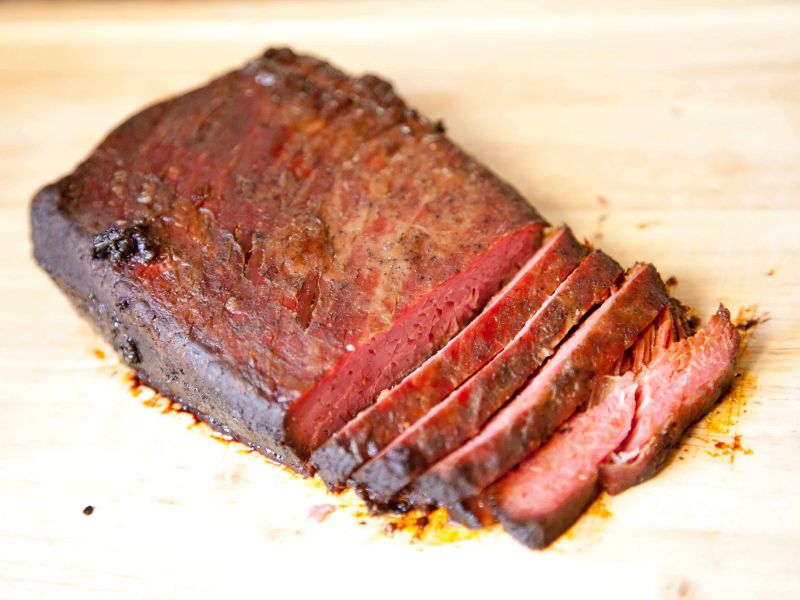
Corned beef can be cooked using various techniques, each requiring specific temperature ranges. Here are some commonly used cooking methods and their corresponding temperatures:
Traditionally, corned beef is prepared by bringing water to a boil and then reducing the heat to a simmer. Simmering is done at a consistent temperature of around 180 to 190 degrees Fahrenheit (82 to 88 degrees Celsius). It is important to maintain this heat level throughout the cooking process.
If you choose to cook corned beef in the oven, it is recommended to use a slightly lower heat. Preheat the oven and cook the corned beef until it reaches an internal temperature of 145 to 160 degrees Fahrenheit (63 to 71 degrees Celsius). To accurately determine the meat’s internal temperature, you can use a meat thermometer.
For those who prefer slow cooking, a slow cooker or crockpot is ideal. Set the temperature between 200 and 300 degrees Fahrenheit (93 and 149 degrees Celsius) and allow the corned beef to cook for several hours, depending on its size. The slow cooking method allows the meat to become tender and flavorful.
It is important to note that corned beef, similar to brisket, is a tough cut that requires extended cooking to achieve tenderness. Therefore, it is advisable to follow the instructions on the package or consult a reliable recipe when preparing corned beef, as cooking times and temperatures may vary depending on the specific cut.
How Do You Tell If Corned Beef Is Cooked Thoroughly?
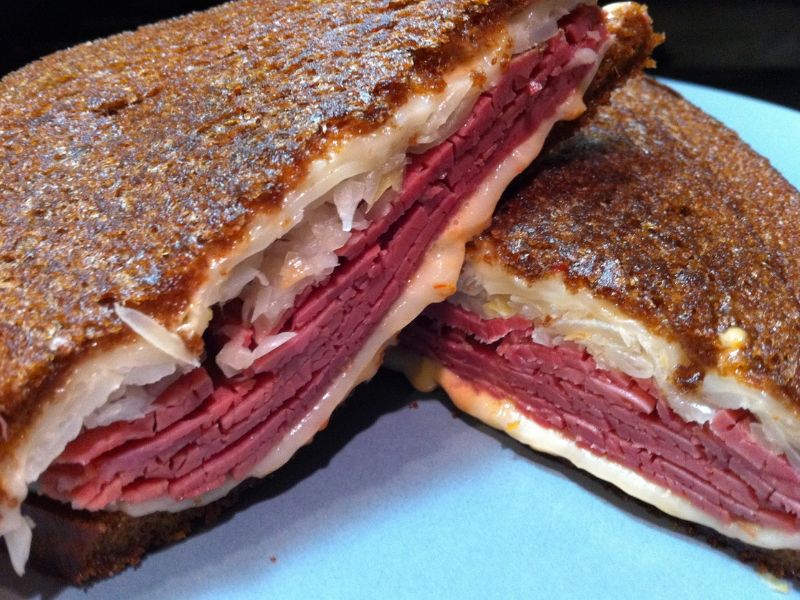
Achieving the desired tenderness and flavor is crucial when cooking corned beef. To determine if your corned beef is ready to be enjoyed, there are several indicators to look out for:
Since cooking methods and recipes can vary significantly, cooking times and temperatures may differ. It is advisable to use the instructions provided in the recipe or on the corned beef package as a starting point.
For accurate results, using a meat thermometer is the most reliable method to determine the doneness of corned beef. When inserting the thermometer into the thickest part of the meat, avoid touching the bone or fat. Medium rare corned beef should reach an internal temperature of 145 degrees Fahrenheit (63 degrees Celsius), while medium requires 160 degrees Fahrenheit (71 degrees Celsius), and well done should reach 170 degrees Fahrenheit (77 degrees Celsius).
Assess the level of tenderness by checking for the breakdown of tough connective tissues in the corned beef during the extended cooking process. Insert a fork into the meat and gently twist it to gauge its delicacy. The meat is considered done when the fork effortlessly slides in and the meat separates easily upon poking. If the meat is still tough, it requires additional cooking time.
While corned beef naturally has a reddish hue due to the curing process, it is important to examine its color. If the meat appears uniformly grayish brown throughout, it is generally an indication that it is done. However, relying solely on color can be less precise, making a meat thermometer a preferable tool to ensure accuracy.
Keep in mind that cooking times for corned beef may vary based on the size and thickness of the cut. As a general guideline, corned beef is typically cooked for 2.5 to 3 hours per pound (0.45 kg). However, instead of relying solely on cooking time, it is essential to assess tenderness and monitor the internal temperature.
To ensure both tenderness and safety when cooking corned beef, it is advisable to err on the side of caution. If in doubt, give the meat a little more time in the oven to guarantee it reaches the desired softness and is safe to consume.
How Long Does It Take For Corned Beef To Get Tender?
The tenderness of corned beef is influenced by several factors, such as the size and thickness of the meat, the cooking method employed, and the desired level of softness. While the cooking time may vary, a general guideline is to allocate 2.5–3.5 hours per pound of corned beef.
Typically, corned beef is made from brisket, a tougher cut of meat. The process of corning involves curing the meat using a brine solution infused with seasonings, which not only imparts flavor but also helps to tenderize the protein. However, due to the meat’s inherent toughness, longer cooking periods are necessary to achieve optimal tenderness.
A common technique for preparing corned beef involves simmering it in a saucepan with an assortment of spices and vegetables, usually in a liquid base such as water or broth. The extended simmering time at a low heat allows the tough connective tissues in the meat to gradually break down, resulting in a more succulent final product. The key to achieving the desired softness lies in the slow and gentle cooking process.
To determine if the corned beef is sufficiently tender, you can employ a fork test. Insert a fork into the meat and if it can be effortlessly inserted and removed with minimal resistance, the meat is likely to be tender. It’s worth noting that different cuts of corned beef may require varying cooking times to achieve the desired degree of tenderness.
Does Corned Beef Get More Tender The Longer It Is Cooked?
Corned beef, a tough cut of meat characterized by its abundance of connective tissue, undergoes a remarkable transformation when cooked properly. The ideal outcome is a delectably tender and flavorful meat, achieved by the breakdown of the connective fibers, rendering them fluid and yielding a delightful texture. However, it’s crucial to exercise caution and avoid overcooking, as corned beef can become dry and stringy if left on the heat for too long. Finding the sweet spot is key.
While prolonged cooking can contribute to the tenderness of corned beef, it is essential to strike a balance to prevent it from drying out and losing its appeal. Excessive flexing of the proteins during cooking can result in the meat toughening once again, diminishing the desired tenderness.
To unlock the full potential of corned beef’s flavor, it is recommended to cook it for an appropriate duration over low to medium heat. The gradual breakdown of connective tissue is what imbues the meat with its sought-after tenderness. As a general guideline, corned beef should be cooked at a gentle simmer for approximately 2.5 to 3.5 hours per pound. However, it’s important to note that precise cooking times may vary depending on factors such as the specific cut of meat, chosen cooking technique, and individual preferences.
To determine if the corned beef has reached the desired level of tenderness, the trusty fork test can be employed. A good indication of tenderness is when a fork can be easily inserted into the flesh and pulled out without encountering significant resistance. If some toughness is still perceptible, it may be necessary to simmer the corned beef for a little longer. However, caution must be exercised to avoid overcooking, which could result in a dry and unappetizing final product. Keeping a close eye on the cooking time is therefore paramount to achieving optimal results.
How Should Corned Beef Be Cooked?
The traditional method of cooking corned beef is through boiling or simmering. Here is a simple guideline to help you prepare corned beef:
To start, obtain a high-quality corned beef brisket, typically packaged in a vacuum-sealed box along with a seasoning packet. Rinse the brisket under cool water to remove any excess salt.
Take a large saucepan and cover the brisket with water, ensuring that it is fully submerged.
You have the option of using the provided corned beef seasoning packet or creating your own blend. Common additions include whole peppercorns, cloves, bay leaves, and mustard seeds. Adjust the spices according to your taste preferences.
Bring the water to a boil over high heat, and once it reaches a boil, reduce the heat to low or medium to allow the liquid to simmer. Depending on the size of the corned beef, it should simmer for approximately 2.5 to 3.5 hours. As a general rule, allocate about 1 hour of cooking time for each pound (0.45 kg) of meat.
While cooking, skim off any contaminants or froth that may rise to the surface.
After the recommended cooking time, check the tenderness of the corned beef. It should be easily pierced with a fork and release with little resistance. If it requires further tenderness, continue to simmer for an additional 30 minutes.
Once the corned beef reaches the desired tenderness, remove it from the cooking liquid and allow it to rest for a few minutes before slicing. For tender slices, slice against the grain of the meat.
Vegetables, such as cabbage, are often enjoyed alongside corned beef and can be added during the final 30 minutes of cooking. This allows the vegetables to absorb some of the flavors from the corned beef and spices.
Is It Ok To Overcook Corned Beef?
Opinions may vary when it comes to the preferred texture of corned beef. While some individuals may not enjoy the firmer and drier texture that results from overcooking, others may find it appealing. Ultimately, the choice of cooking time and desired texture is a personal preference. However, if you aim for a tender and flavorful outcome, many traditional corned beef recipes recommend cooking the meat for an extended period, sometimes even spanning several hours or days.
Individual preferences regarding texture can differ greatly. Some people prefer their corned beef to have a solid and firm consistency, while others prefer it to easily break apart. Overcooking corned beef can lead to a tough and less desirable texture, so it is advisable to avoid doing so if you desire a softer outcome.
However, if you prefer a tougher texture or plan to use the corned beef for slicing, it may be acceptable to simmer the meat for a longer duration. By experimenting with different cooking times, you can discover the ideal level of doneness that suits your particular dish. This way, you can achieve the desired texture and enjoy a satisfying corned beef experience.
Is Corned Beef Overcooked Or Undercooked If It’s Tough?
The tenderness of corned beef primarily depends on the cooking time rather than the level of cooking. Achieving a tender texture in tougher cuts of corned beef requires a methodical approach of cooking it slowly and at a lower temperature to effectively break down the connective fibers. Insufficient cooking time can result in chewy and rough corned beef, as the connective fibers have not had enough time to fully dissolve.
To ensure that corned beef reaches the desired tenderness, it needs to be cooked for a considerable duration. The cooking time can vary based on the size and thickness of the meat. Many people prefer using a slow cooker or braising the corned beef for several hours, allowing it to become tender enough that it can be effortlessly cut with a fork. The slow cooking process aids in the breakdown of collagen present in the meat, transforming it into gelatin and ultimately resulting in a softer texture.
If corned beef is not tender enough throughout the cooking process, it may require additional cooking time. Alternatively, employing alternative cooking techniques such as slow cooking or pressure cooking can also be effective in tenderizing the meat, providing it with the necessary time to reach the desired level of tenderness.
How Much Corned Beef Per Person
The amount of corned beef each individual should consume is influenced by various factors, such as personal appetite, the availability of alternative food options, and whether the corned beef is being served as the main course or as part of a larger meal. As a general guideline, it is recommended to serve approximately a quarter to a half pound (115 to 225 grams) of cooked corned beef per person.
When considering this serving suggestion, it is assumed that corned beef serves as the primary source of protein, and other accompanying side dishes are taken into account within this estimate.
However, if corned beef is being served as a secondary protein option or is part of a buffet-style meal, it is appropriate to reduce the portion size to around 1/4 pound (115 grams) per person. It’s important to consider the preferences of your guests and adjust the serving sizes accordingly, ensuring that everyone’s tastes and appetites are accommodated.

